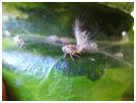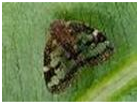Patch from Scratch – March
March 1st is officially the beginning of autumn and a signal to vege gardeners that we are moving onto the next season. No no no! I’m not ready to start thinking about soups and stews yet! Hopefully it will be a long summer like last year.
Have you noticed little brown moths on your beans and berry bushes? I’ve had a few problems with these this year, so I dug out some info from a previous newsletter to share with our newcomers. Also, Powdery mildew is always around at this time of year, so Kate has had a look into it and found some practical info on how to deal with it. Talking of Kate, she finished up with Patch from Scratch at the end of February to try her hand at something different – thanks for all the great work you did.
Every year I like to grow unusual fruits and veges, usually that I have never heard of, just to see what they’re like. Koanga gardens tells us that we have around 1% left of the seed we held 100 years ago! Those figures blew me away, we don’t even know what we’re missing out on. Apart from organic heritage seeds being really nutritious, this is another good reason to always opt for them when you’re buying seed.
Last July I planted a little Babaco tree and it already has some fruit starting to grow. Talking of fruit, all my fruit trees are young, and not yet producing (apart from the above), so, if you have excess from your trees that you’d like to share,(I love Feijoas, plums, loquats anything really, I’m not fussy!) and live in the Auckland area, flick me an email and I’ll happily come and pick it!
Autumn Garden Maintenance
Over the next couple of weeks, make time to get your vege patch in order.
- Cut back your herbs to prevent them going to seed
- Pull out any summer crops that are past it and no longer producing and put them in the compost – don’t leave the debris lying around in the garden as this can encourage pests and the spread of infestation.
- Give the compost a good turn over
- Plant your autumn crops (see recommended list below) while the soil is still warm. If you are using raised beds, the season will be extended for you as the warmth is held in the soil longer than if you are planting into the ground.
- Sow a green manure crop in any vegetable beds that won’t be used over winter.
Passion Vine Hopper

Passion Vinehopper nymph

Passion Vinehopper adult
The passion vine hopper over-winters as an egg, usually inserted into a plant stem (they generally prefer soft stems). From October onwards and for around three months they are in nymph stage and can be recognised by their little fluffy tails. Following this they reach adult stage and look like a small brown moth. In the vege garden, passion vine hoppers are most frequently found on beans, berry fruits, kiwi fruits and citrus. Also be aware of nearby flowers that they maybe inhibiting. Braken, lantaria, flax, hydrangas and jasmine are amongst their favourites.
Passion Vine Hoppers may not look as though they are causing much damage on the surface, but they are sap suckers and will take the goodness from succulent shoots, leaving plants and fruits stunted, wilting and distorted.
In order to successfully get control of the Passion Vine Hopper it is important to consider not only the adult moth that is around now but any eggs that will be over-wintering. If you are following a crop rotation then uprooting all the stems at the end of the season will get rid of any eggs within these stems assuming you dispose of them accordingly (don’t put them in the compost).
If they have infested perennials then you may need to bring in the big guns, the natural & organic ones that is!
• Mix up a spray of ½ Neem tree oil and ½ garlic and Pyrethrum spray it after dusk on the affected areas.
• Repeat 1 x week for a month then fortnightly until all gone.
Also, get some Neem granules and spread around the base of affected plants.
The Neem granules breakdown into the root zone then translocate through the foliage. When eaten the pest gets a small does of Neem and will then die later.
The Pyrethrum is deactivated by UV and is harmful to bees as well as other beneficial insects, so only use in the evening. Only use Neem in the evening too.
In addition to this, you can plant some companions that repel the Passion Vine Hopper such as Chamomile, Coriander, Geranium, Marjoram, Petunia, and Yarrow.
Powdery Mildew

Powdery mildew is a common, but damaging fungus. It affects a number of plants, Beans, courgettes, pumpkins and cucumbers as well as fruits and flowers. There are a number of different types of powdery mildew and each type is specific to the plant it is affecting. The yellow and black spotted ladybirds feed on the fungi, which you’d think would be a good thing, but actually they spread it more than they eat it by carrying spores under their wings! It doesn’t directly hit the fruit, but the damaged leaves can’t feed the fruit as well, and the fruit can be damaged by the sun as a result of less leaf cover. There are number of things you can do to help prevent and control it.
• The safest organic remedy for powdery mildew is to mix 1 teaspoon baking soda, a few drops of liquid soap and 1 Litre water then spray on affected leaves.
• Neem oil can also be used. This is a commonly used bio -pesticide in organic farming. As well as repelling a variety of insects it controls powdery mildew, black spot and rust. But do take care when using it and avoid it if completely if you are pregnant or trying to conceive! Yikes!
• Ensure good airflow around plants by effective spacing, pruning dense foliage, and keeping the ground weed free.
• Water the ground around the plant and try to keep the hose off the leaves as humidity can speed up the growth considerably.
• Make sure you clean up your garden and discard of any affected plants and debris well at the end of the season to get the spores out of your garden.
• Following a 4 yearly crop rotation is very important to minimise the extent of the powdery mildew damage. If you replant next season in the same spot then the spores will be prevalent in that area leading to an even bigger problem next growing season!
What to plant in March
Beetroot Broccoli Celery Cauliflower
Cabbage Carrot Chinese Cabbage Kohlrabi
Leeks Lettuce Pumpkin Perpetual Spinach
Peas Parsnip Rocket Rainbow Chard
Silverbeet
If you want to grow your own veggies and could do with a helping hand to get the right start, then you may want to seek help. Patch from Scratch offers an all inclusive service building and maintaining veggie beds for beginner organic gardeners and busy people. We also offer Kits sets for DIY enthusiasts and a consultancy service for people who really want to do it all themselves but just need a bit of guidance.
For more on our services go to www.patchfromscratch.co.nz or call us for details 09 525 7897 / 021 334 603.
Happy Gardening!
Sarah Davies
Patch from Scratch Ltd
PO Box 11105
Ellerslie 1542, Auckland
phone 09 525 7897
mobile 021 334 603
email sarah@patchfromscratch.co.nz
www.patchfromscratch.co.nz


